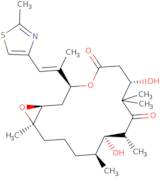Epothilone B (synthetic)
CAS: 152044-54-7
Ref. 3D-FE22751
| 2mg | Discontinued | ||
| 5mg | Discontinued | ||
| 10mg | Discontinued | ||
| 25mg | Discontinued | ||
| 50mg | Discontinued |
Product Information
- (1S,3S,7S,10R,11S,12S,16R)-7,11-Dihydroxy-8,8,10,12,16-pentamethyl-3-[(1E)-1-methyl-2-(2-methyl-4-thiazolyl)ethenyl]-4,17-dioxabicyc lo[14.1.0]heptadecane-5,9-dione(-)-Epothilone BEPO 906
- (1S,3S,7R,10S,11S,12S,16R)-7,11-dihydroxy-8,8,10,12,16-pentamethyl-3-[(1E)-1-(2-methyl-1,3-thiazol-4-yl)prop-1-en-2-yl]-4,17-dioxabicyclo[14.1.0]heptadecane-5,9-dione
- (1S,3S,7S,10R,11S,12S,16R)-7,11-Dihydroxy-8,8,10,12,16-pentamethyl-3-[(1E)-1-methyl-2-(2-methyl-4-thiazolyl)ethenyl]-4,17-dioxabicyclo[14.1.0]heptadecane-5,9-dione
- (1S,3S,7S,10R,11S,12S,16R)-7,11-Dihydroxy-8,8,10,12,16-pentamethyl-3-[(E)-1-(2-methylthiazol-4-yl)prop-1-en-2-yl]-4,17-dioxabicyclo[14.1.0]heptadecane-5,9-dione
- (1S,3S,7S,10R,11S,12S,16R)-7,11-dihydroxy-8,8,10,12,16-pentamethyl-3-[(1E)-1-(2-methyl-1,3-thiazol-4-yl)prop-1-en-2-yl]-4,17-dioxabicyclo[14.1.0]heptadecane-5,9-dione
- 4,17-Dioxabicyclo[14.1.0]heptadecane-5,9-dione, 7,11-dihydroxy-8,8,10,12,16-pentamethyl-3-[(1E)-1-methyl-2-(2-methyl-4-thiazolyl)ethenyl]-, (1S,3S,7S,10R,11S,12S,16R)-
- 4,17-Dioxabicyclo[14.1.0]heptadecane-5,9-dione, 7,11-dihydroxy-8,8,10,12,16-pentamethyl-3-[1-methyl-2-(2-methyl-4-thiazolyl)ethenyl]-, [1S-[1R*,3R*(E),7R*,10S*,11R*,12R*,16S*]]-
- Epo 906
- Epo 906A
- Epo B
- See more synonyms
- Patupilone
- [1S-[1R*, 3R* (E) , 7R*, 10S*, 11R*, 12R*, 16S*]]-7,11-dihydroxy-8,8,10,12,16-pentamethyl-3-[1-methyl-2-(2-methyl-4-thiazolyl) ethenyl]-4,17-dioxabicyclo[14.1.0]heptadecane-5,9-dione
- (-)-Epothilone B
- Epothilone B
Epothilone B is a macrocyclic and trisubstituted epothilone that belongs to the class of myxobacterium. Epothilones are synthesized from natural products, such as taxol, which are found in plants such as yew trees. Epothilones stabilize microtubules by binding to their surfaces and preventing them from disassembling. This stabilizing effect is useful for the treatment of cancer cells that have stabilized microtubules. Epothilones have been shown to be effective against paclitaxel-resistant cells in both porcine and human models. Epothilones also stabilize cellular membranes and inhibit protein synthesis, leading to cell death by inhibiting production of proteins vital for cell division.





